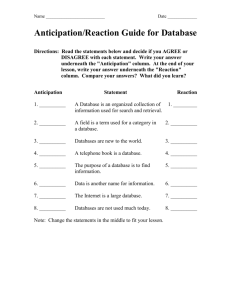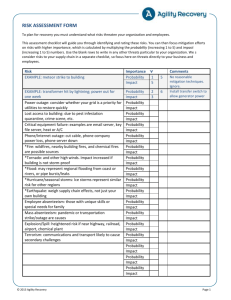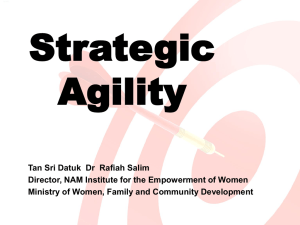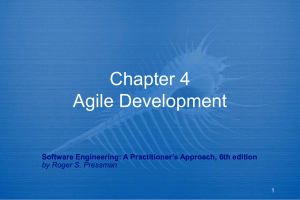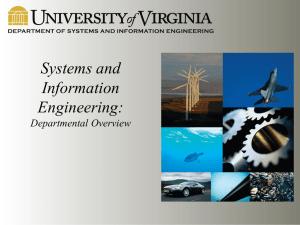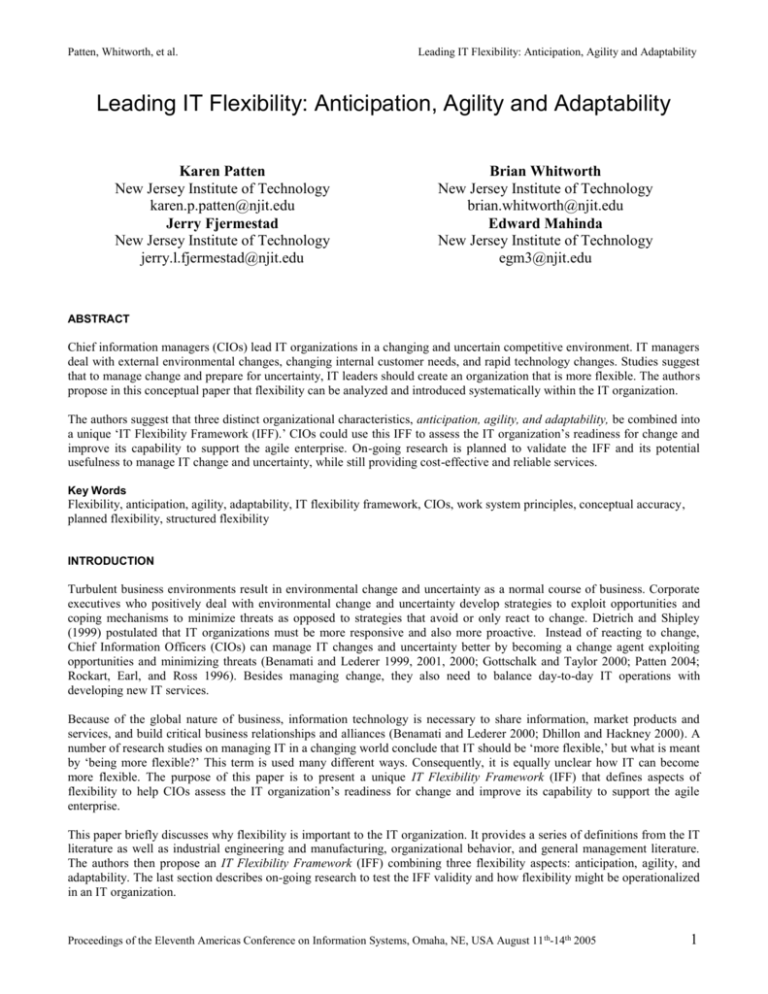
Patten, Whitworth, et al.
Leading IT Flexibility: Anticipation, Agility and Adaptability
Leading IT Flexibility: Anticipation, Agility and Adaptability
Karen Patten
New Jersey Institute of Technology
karen.p.patten@njit.edu
Jerry Fjermestad
New Jersey Institute of Technology
jerry.l.fjermestad@njit.edu
Brian Whitworth
New Jersey Institute of Technology
brian.whitworth@njit.edu
Edward Mahinda
New Jersey Institute of Technology
egm3@njit.edu
ABSTRACT
Chief information managers (CIOs) lead IT organizations in a changing and uncertain competitive environment. IT managers
deal with external environmental changes, changing internal customer needs, and rapid technology changes. Studies suggest
that to manage change and prepare for uncertainty, IT leaders should create an organization that is more flexible. The authors
propose in this conceptual paper that flexibility can be analyzed and introduced systematically within the IT organization.
The authors suggest that three distinct organizational characteristics, anticipation, agility, and adaptability, be combined into
a unique ‘IT Flexibility Framework (IFF).’ CIOs could use this IFF to assess the IT organization’s readiness for change and
improve its capability to support the agile enterprise. On-going research is planned to validate the IFF and its potential
usefulness to manage IT change and uncertainty, while still providing cost-effective and reliable services.
Key Words
Flexibility, anticipation, agility, adaptability, IT flexibility framework, CIOs, work system principles, conceptual accuracy,
planned flexibility, structured flexibility
INTRODUCTION
Turbulent business environments result in environmental change and uncertainty as a normal course of business. Corporate
executives who positively deal with environmental change and uncertainty develop strategies to exploit opportunities and
coping mechanisms to minimize threats as opposed to strategies that avoid or only react to change. Dietrich and Shipley
(1999) postulated that IT organizations must be more responsive and also more proactive. Instead of reacting to change,
Chief Information Officers (CIOs) can manage IT changes and uncertainty better by becoming a change agent exploiting
opportunities and minimizing threats (Benamati and Lederer 1999, 2001, 2000; Gottschalk and Taylor 2000; Patten 2004;
Rockart, Earl, and Ross 1996). Besides managing change, they also need to balance day-to-day IT operations with
developing new IT services.
Because of the global nature of business, information technology is necessary to share information, market products and
services, and build critical business relationships and alliances (Benamati and Lederer 2000; Dhillon and Hackney 2000). A
number of research studies on managing IT in a changing world conclude that IT should be ‘more flexible,’ but what is meant
by ‘being more flexible?’ This term is used many different ways. Consequently, it is equally unclear how IT can become
more flexible. The purpose of this paper is to present a unique IT Flexibility Framework (IFF) that defines aspects of
flexibility to help CIOs assess the IT organization’s readiness for change and improve its capability to support the agile
enterprise.
This paper briefly discusses why flexibility is important to the IT organization. It provides a series of definitions from the IT
literature as well as industrial engineering and manufacturing, organizational behavior, and general management literature.
The authors then propose an IT Flexibility Framework (IFF) combining three flexibility aspects: anticipation, agility, and
adaptability. The last section describes on-going research to test the IFF validity and how flexibility might be operationalized
in an IT organization.
Proceedings of the Eleventh Americas Conference on Information Systems, Omaha, NE, USA August 11 th-14th 2005
1
Patten, Whitworth, et al.
Leading IT Flexibility: Anticipation, Agility and Adaptability
THE NEED FOR IT ORGANIZATIONAL FLEXIBILITY
IT organizations are difficult to manage because IT complexity and uncertainty is accelerated by technological change,
increased outsourcing and IT alliances, and compressed product life cycles (Mahinda and Whitworth 2004). Information
technology has removed the geographical constraints of enterprises, dispersed control and authority within the enterprise,
increased the speed of transactions, and changed the way companies do business (Patten 2000; Santhanam and Hartono
2003). The structure of the IT organization affects how IT services and solutions help an enterprise sustain a competitive
edge, increase its business, and compete in an Internet-enabled economy (Malhorta 1993; Santos and Fjermestad 2002). In
the digital enterprise, internal IT customers have changing needs that often conflict requiring new IT solutions that must
interoperate with embedded IT services (Sambamurthy, Bharadwaj, and Grover 2003; Sambamurthy and Zmud 2000). IT
executives struggle with the conflicting mission of providing a robust and scalable IT infrastructure at the same time lowering
costs and being efficient. Certain IT solutions may be beneficial for some functional organizations and detrimental for others.
Silver, Markus, and Beath (1995) argue that increased IT investments actually hinder the flexibility of business processes and
the effectiveness of the organization. The simple question is how should CIOs create and then lead an IT organization where
the IT infrastructure is flexible, but yet efficient, effective, and reliable?
The goal of introducing IT flexibility within the organization should be to leverage opportunities that come from external
change and uncertainty while at the same time minimizing the threats. Leveraging opportunities requires the capability to
recognize opportunities and to creatively or innovatively initiate change. Minimizing threats requires the capability to assess
risks and develop alternatives. Both require immediate action. IT flexibility impacts all components of an IT organization –
its management including leadership and its necessary processes, policies, and practices, its personnel including customers,
suppliers, and partners, and its infrastructure including hardware, software, products, and services. Earlier studies recommend
that to be more flexible, IT organizations should precipitate intentional changes, continuously responding to unanticipated
changes, and adjusting to unexpected consequences of predictable changes (Bahrami 1991; Knoll and Javenpaa 1994).
FLEXIBILITY DEFINITIONS
Frost (1999) maintains that people generally understand the need for flexibility, but understanding the need does not lead to
implementation. Terms are often used interchangeably causing a lack of precision, which necessitates terms to be carefully
defined resulting in conceptual accuracy (Shee 2001). Flexibility is considered a multi-dimensional concept with different
connotations, paradigms, foundations, dimensions (Sushil 2001). Flexibility and its synonyms – hedging, malleability,
pliability, resilience, robustness, and versatility – are often used interchangeably as are flexibility and its closely related
attributes – anticipation, agility, and adaptability (Evans 1991).
Dictionary definitions of flexibility vary by application as shown in Table 1. A classic manufacturing industry definition is
the ability to change or react with little penalty in time, effort, cost, or performance (Upton 1994). An U. S. Army definition
is “to be responsive to change and adaptable to the volatility, pressures, and complexities of military operations, while
constantly focusing on the objective” (Frost 1999). Different fields also have different definitions of flexibility. Sethi and
Sethi (1990) developed eleven different types or flexibility and measurements in operations management.
Flexibility also relates to specific business functions including strategic, manufacturing, human resources, financial,
technology, marketing, organizational, and IT/IS. Because the management of technology is key to competitiveness and
wealth creation, a technology perspective is an important criteria when evaluating flexibility and competitiveness (Khalil
2001). Certainly, many IT managers would agree with Frost’s military definition that IT operations include a number of
volatilities and complexities, although not viewed as a life or death decision.
Flexibility is also the ability to predict and sense environmental change and to respond appropriately. A flexible system
should have ability to effectively adapt or respond to environmental change to take advantage of opportunity and to minimize
threats (Whitworth and Zaic 2003). Duncan (1995) found that no common, operational definition of IT infrastructure
flexibility existed. He also concluded that the characteristics of infrastructure will vary by firm resources and industry
characteristics such as information intensity. Therefore flexibility might be encouraged or discouraged based on different
perceptions.
Proceedings of the Eleventh Americas Conference on Information Systems, Omaha, NE, USA August 11 th-14th 2005
2
Patten, Whitworth, et al.
Leading IT Flexibility: Anticipation, Agility and Adaptability
Knoll and Javenpaa (1994) defined flexibility as the ability of software to change or fit the changing turbulent environment.
Nadler and Tushman (1980) defined fit as the degree to which the needs, demands, goals, objectives, and/or structure of one
component are consistent with those of another component.
hyperdictionary,
Merriam-Webster Online
Flexibility\flex’i’bil’ty
n 1. The property of being flexible; capable of being flexed : pliant.
Synonyms: flexibleness, malleability, inflexibility, bendability.
n 2. The quality of being adaptable or variable; characterized by a ready
capability to adapt to new, different, or changing requirements.
Synonyms: adaptability, flexibility, wiggle room.
n 3. The trait of being easily persuaded; yielding to influence : tractable.
Synonyms: manipulable, manageability, docility, domestication, obedience.
Anticipation\an’tic’i’pa’tion
n 1a. A prior action that takes into account or forestalls a later action.
1b. The act of looking forward; especially : pleasurable expectation.
Synonyms: expectancy, hope, suspense, fever.
n 2a. Visualization of a future event or state; the act of predicting (as by
reasoning about the future.)
2b. An object or form that anticipates a later type.
Synonyms: prediction, prognostication, foreshadowing, projection, forecast.
Agility\agil’i’ty
n 1. The property of being flexible.
Synonyms: flexibleness, malleability, inflexibility, bendability, whip.
n 2. The quality or state of being agile : nimbleness, dexterity, quickness;
quickness of motion.
Synonym: legerity, lightness, lightsomeness, nimbleness.
Adaptability\a’dapt’a’bil’i’ty
n 1. The ability to change or be changed to fit changed circumstances.
Synonym: ability, flexibility, pliability.
Table 1. Flexibility Definitions
ASPECTS OF FLEXIBILITY
The authors concluded that the definition of flexibility is not as simple as one size fits all, but that three related aspects,
anticipation, agility, and adaptability, should be considered. Combining these aspects into a framework for managing IT in a
changing and uncertain environment should improve understanding and use. Anticipation balances planning for expected
change with preparing for unexpected change. Agility is the capability to respond quickly to environmental change. And,
adaptability is the capability of the organization to self-learn and self-organize based on previous experience. The dictionary
definitions are also shown in Table 1.
Anticipation and Flexibility
It is recommended that that the first step of becoming more flexible is to anticipate what might happen by planning for the
known and preparing for the unknown. Aligning the IT strategy with the business strategy is an example of anticipation
(Luftman 2004; Luftman, Papp, and Brier 1999). Sledgianowski, Luftman, and Reilly (2004) identified factors, which
determine an organization’s ability to align its business/IT strategies. Aligning the business / IT strategy and preparing
tactical/operational plans demonstrates that the IT organization understands the known business needs and is the first step to
becoming more flexible. These plans should be considered guidelines since unanticipated changes will change the plans.
The ability to anticipate provides the opportunity to plan and then prepare. Forecasting, scanning the Internet, and analyzing
trends are management tools used to predict. This helps managers to make decisions about what products to make, where to
Proceedings of the Eleventh Americas Conference on Information Systems, Omaha, NE, USA August 11 th-14th 2005
3
Patten, Whitworth, et al.
Leading IT Flexibility: Anticipation, Agility and Adaptability
ship, when to hire, etc. Plus, anticipating competitive actions allows managers to take steps to minimize the potential
competitive threats.
Environmental change and uncertainty especially impacts IT product development processes (PDP). Verganti (1999) defines
planned flexibility as the capability to clearly identify all the critical areas early in a project and to plan for the key reaction
measures that may be necessary later. This allows the project team to link both anticipation and reaction in order to minimize
the problems of anticipating constraints and opportunities too early in the product development process when uncertainty is
greater versus delaying PDP decisions to later when uncertainty decreases, but cost and time to take corrective action
increase. Product development teams must be able to both anticipate and react, a function, Verganti describes as structural
flexibility. Structured flexibility is impossible unless planned flexibility is built during the early stages of the project.
Agility and Flexibility
Agility is the ability to both create and respond to change in order to profit in a turbulent business environment (Goldman,
Nagel, and Preiss 1995). Business agility is rapidly becoming the focus of managers trying to be more competitive in a global
economy. Agile manufacturing has developed methods over the last fifteen years that can be applied to the IT organization.
Agile software development is used by some organizations, but not by all.
Critics argue that agility is really the lack of planning or just reacting in an ad hoc manner. Supporters argue, agile managers
plan for both the known and the unknown (Schrage 2004). It is recommended that the next step of becoming more flexible is
to train employees to be able to sense changes when they occur and use processes and practices that are designed to be
flexible based on changes occurring. Agile managers act versus react to respond quickly and effectively to both anticipated
and unanticipated business changes.
Adaptability and Flexibility
Adaptability has different IT-related definitions. Some include the change in the system to accommodate change in its
environment, the ease of system/component modification, the modification of behavior in response to environmental
changes; and the adjustment to changing requirements. Adaptability is also a non-functional (software) requirement (NFR).
Applying Alter’s (2004) work system principles to the IT organization implies that the IT organization, as a system, should
have the capability to adapt, change, and grow. Alter’s research found that sometimes IT supports adaptability, but other
times, IT constrains adaptability as stated in his Principle #21:
Principle #21. Maintain the ability to adapt, change, and grow – recognizes that environments will change over time.
Alter also found that his Principle #21 had the highest acceptability of all 21 principles, but also has the highest difference
between applicability and reality. In other words, respondents agreed that this is very important, but rarely applied it.
Terreberry (1968) hypothesized that organizational adaptability is a function of the ability to learn and to perform according
to changing environmental contingencies. Jaruzelski and Kumar (2004) define adaptability as the capacity to anticipate,
trigger, and absorb change whether cyclical or structural where flexibility is the capability to adapt the quantity and the
quality of each factor as it either re-acts or pro-acts to environmental changes. Adapting emphasizes the ability to maintain
the status quo despite an internal or external change, also referred to as robustness – the ability to maintain status quo.
Change emphasizes the ability to instigate change not react to change, also referred to as agility – the ability to instigate
change.
IT FLEXIBILITY FRAMEWORK
The above definitions suggest aspects of flexibility that focus on dealing with change (Whitworth and Zaic 2003). Since
external changes always occur, uncertainty will always be present. The CIO has created and is leading a flexible IT
organization when the organization is prepared:
1. To anticipate the change, giving time to prepare through forecasting and planning (anticipation).
2. To wait for the change to occur, then to react quickly and fix the problems that occur as effectively as possible (agility).
Proceedings of the Eleventh Americas Conference on Information Systems, Omaha, NE, USA August 11 th-14th 2005
4
Patten, Whitworth, et al.
Leading IT Flexibility: Anticipation, Agility and Adaptability
This is not an either/or choice, as he or she can do both. However, each is distinct from the other, as an entity can be agile
without anticipation, and anticipate without being agile. In both cases, flexibility increases.
There is yet a third option, where an entity has neither agility nor anticipation, yet still develops flexibility. This option,
adaptability, is the ability to develop or learn both anticipation and agility from experiences. An example is a small baby,
who is neither agile nor able to anticipate, yet is highly adaptive and able to learn.
This paper suggests that flexibility can be systematically analyzed and introduced within the IT organization. However, all
three distinct aspects: anticipation, agility, and adaptability, should be used by an IT organization wishing to become more
flexible. We propose that these aspects be combined into an IT Flexibility Framework in a continuous cycle as shown in
Figure 1. First, anticipation balances planning for expected change with preparing for unexpected changes within the
organization. Then, over time, situations change requiring agility, the capability to respond quickly to the environmental
changes. And, finally, after responding to the changes, adaptability is the capability of the organization to self-learn and selforganize based on previous experience. Then the organization starts the cycle over by beginning the anticipation stage again.
1. Anticipation
2. Agility
3. Adaptability
Figure 1. IT Flexibility Framework
CONCLUSIONS AND FUTURE RESEARCH
This paper describes the need for IT flexibility and proposes an IT Flexibility Framework (IFF) with three critical aspects that
any IT organizations should consider. This IFF is part of a long term study expected to develop a roadmap for CIOs to use to
assess the potential for flexibility within the IT organization, to determine where improvements should be made, and to
provide guidelines on how to become more flexible. Research is underway to assess the validity of the IFF, test its potential
use and effectiveness, and develop methods to increase flexibility within the IT organization. On-going research will
demonstrate how CIOs can manage change and uncertainty within the IT organization, while still providing cost-effective
and reliable services.
REFERENCES
1.
2.
3.
4.
5.
6.
7.
8.
9.
Alter, S. (2004) Making work system principles visible and usable in systems analysis and design, Proceedings of the
Tenth Americas Conference on Information Systems, August, New York NY.
Bahrami, H. (1991) The flexible organization: Perspectives from silicon valley, California Management Review, 33-52.
Benamati, J. and Lederer, A. L. (1999) The effect of emerging IT groups on coping with rapid IT change, Proceedings of
the Fourth Americas Conference on Information Systems, August 13-15, Milwaukee, WI.
Benamati, J. and Lederer, A. L. (2000) The emerging IT group and rapid IT change, SIGCPR Computer Personnel,
ACM.
Benamati, J. and Lederer, A. L. (2001) Coping with rapid changes in IT, Communications of the ACM, 44, 8, 83-88.
Dhillon, G. and Hackney, R. (2000) IS/IT and dynamic business change, Proceedings of the 33rd Hawaii International
Conference on System Sciences.
Dietrich, G. B. and Shipley, M. B. (1999) Technology strategies in complex environments, Proceedings of the 33rd
Hawaii International Conference on System Sciences.
Duncan, N. B. (1995) Capturing flexibility of information technology infrastructure: A study of resource characteristics
and their measures, Journal of Management Information Systems, 12, 2, 37-57.
Evans, J. S. (1991) Strategic flexibility for high technology maneuvers: A conceptual framework, Journal of
Management Studies, 2, 1, 69-89.
Proceedings of the Eleventh Americas Conference on Information Systems, Omaha, NE, USA August 11 th-14th 2005
5
Patten, Whitworth, et al.
Leading IT Flexibility: Anticipation, Agility and Adaptability
10. Frost, R. S. (1999) The Growing Imperative to Adopt ‘Flexibility’ as an American Principle of War, Strategic Studies
Institute, U. S. Army War College, Carlisle PA.
11. Goldman, S. L., Nagel, R. N. and Preiss, K. (1995) Agile Competitors and Virtual Organizations: Strategies for
Enriching the Customers, Van Nostrand Reinhold.
12. Gottschalk, P. and Taylor, N. J. (2000) Strategic management of IS/IT functions: The role of the CIO, Proceedings of the
33rd Hawaii International Conference on System Sciences.
13. Jaruzelski, B. and Kumar, J. (2004) Technology's blind spot: Adaptability, optimizemag.com, November.
14. Khalil, T. M. (2001) Management of Technology: The Drivers of Technological Changes in the Twenty-first Century,
Coral Gables FL, University of Miami.
15. Knoll, K. and Javenpaa, S. L. (1994) Information technology alignment or ‘fit’ in highly turbulent environment: The
concept of flexibility, SIGCPR Computer Personnel, ACM.
16. Luftman, J. (2004) Managing the Information Technology Resource, Upper Saddle River NJ, Pearson Prentice Hall.
17. Luftman, J., Papp, R. and Brier, T. (1999) Enablers and inhibitors of business - IT alignment, Communications of the
ACM, 1, 11.
18. Mahinda, E. and Whitworth, B. (2004) Flexibility and reliability in information system evaluation, Proceedings of the
Tenth Americas Conference on Information Systems, August, New York NY.
19. Malhorta, Y. (1993) Role of Information Technology in Managing Organizational Change and Organizational
Independence, BRINT Institute.
20. Nadler, D. A. and Tushman, M. L. (1980) A congruence model for diagnosing organizational behavior, Miles, R. (Ed.)
Resource Book in Macro Organizational Behavior, Santa Clara CA, Goodyear, 30-49.
21. Patten, K. (2000) Data Networking Made Easy, Newport RI, Aegis Publishing.
22. Patten, K. (2004) How CIOs balance flexibility and reliability in uncertain business environments, International Journal
of Computers, Systems and Signals, 5, 1, 3-15.
23. Rockart, J. F., Earl, M. J. and Ross, J. W. (1996) Eight imperatives for the new IT organization, Sloan Management
Review, 38, 1, 43-55.
24. Sambamurthy, V., Bharadwaj, A. and Grover, V. (2003) Shaping agility through digital options: Reconceptualizing the
role of information technology in contemporary firms, MIS Quarterly, 27, 2, 237-263.
25. Sambamurthy, V. and Zmud, R. W. (2000) The organizing logic for an enterprise's IT activities in the digital era - A
prognosis of practice and a call for research, Information Systems Research, 11, 2, 105-111.
26. Santhanam, R. and Hartono, E. (2003) Issues in linking information technology capability to firm performance, MIS
Quarterly, 27, 1, 125-153.
27. Santos, J. and Fjermestad, J. (2002), Global information systems, Proceedings of the Eighth Americas Conference on
Information Systems, August, Dallas TX.
28. Schrage, M. (2004) The struggle to define agility, CIO, August 15.
29. Sethi, A. K. and Sethi, S. P. (1990) Flexibility in manufacturing: A survey, The International Journal of Flexible
Manufacturing Systems, 2, 289-398).
30. Shee, H. (2001) Flexibility and competitiveness: Case of software / services firms in India, Global Journal of Flexible
Systems Management, October - December.
31. Silver, M. S., Markus, M. L. and Beath, C. M. (1995) The interaction model: A foundation for the MBA core course,
MIS Quarterly, 19, 3, 361-390.
32. Sledgianoski, D., Luftman, J. N. and Reilly, R. R. (2004) Identification of IT-business strategic maturity factors: An
exploratory study, Proceedings of the Tenth Americas Conference of Information Systems, August, New York NY.
33. Sushil (2001) Flexibility in technology management: Global imperatives, Sushil and Momaya, K. (Eds.) Globalization,
Flexibility and Competitiveness: A Technology Management Perspective. New Delhi, Vikas.
34. Terreberry, S. (1968) The evolution of organizational environments, Administrative Science Quarterly, 12, 590-613.
35. Upton, D. M. (1994) The management of manufacturing flexibility, California Management Review, 36, 2.
36. Verganti, R. (1999) Planned flexibility: Linking anticipation and reaction in PD projects II, JPIM, 16, 363-376.
37. Whitworth, B. and Fjermestad, J. (2005) The web of system performance: A multi-goal model of information system
performance, Communications of the ACM, in press.
38. Whitworth, B. and Zaic, M. (2003) The WOSP model: Balanced Information system design and evaluation,
Communications of the ACM, 12, 258-282.
Proceedings of the Eleventh Americas Conference on Information Systems, Omaha, NE, USA August 11 th-14th 2005
6

